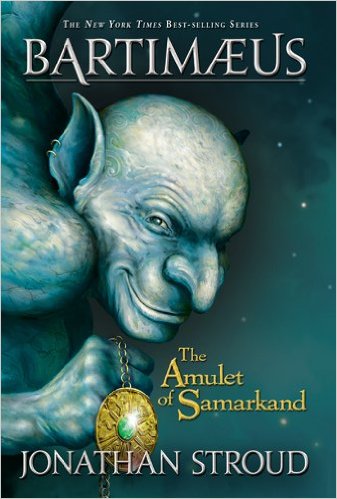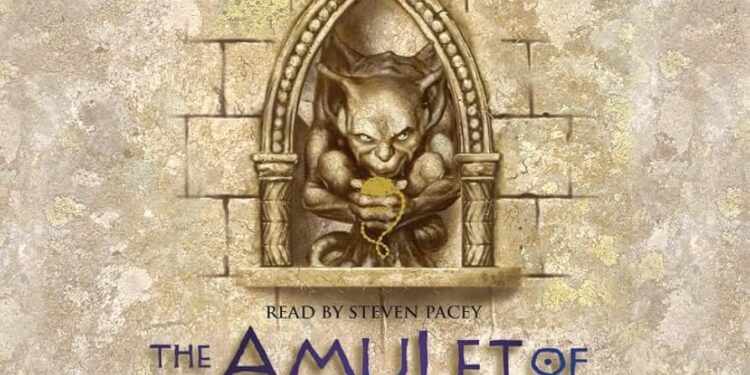Table of Contents
ToggleIntroduction
The Amulet Of Samarkand Summary By Jonathan Stroud The Amulet of Samarkand is the first book in Jonathan Stroud’s captivating fantasy series The Bartimaeus Trilogy. A unique blend of adventure, magic, and intrigue, this novel sets the stage for an unforgettable journey through a world of wizards, magical creatures, and political machinations. Published in 2003, the novel introduces readers to an alternate London where magicians wield immense power, and the use of magical entities, known as djinns, plays a central role in the dynamics of society.
The story is told from the perspectives of two main characters: Nathaniel, a young and ambitious magician’s apprentice, and Bartimaeus, a centuries-old djinn who is forced into servitude. Together, they become embroiled in a dangerous plot that could change the course of history, involving not just magic, but also betrayal, revenge, and the complex relationships between master and servant.
Stroud’s novel is rich in world-building, combining elements of traditional fantasy with wit, humor, and a modern sensibility. The dynamic between Nathaniel and Bartimaeus, a relationship defined by manipulation, mutual disdain, and unexpected cooperation, is at the heart of the book’s appeal. The story is not only a fast-paced, magical adventure but also an exploration of power, morality, and the human (or djinn) condition.
Summary of The Amulet of Samarkand
Setting and Premise
The novel is set in an alternate version of London during the early 19th century, in a world where magic is real, and its use is tightly controlled by a powerful class of magicians. These magicians, who control the fate of the masses, summon magical beings known as “djinns” to perform tasks for them. These djinns, along with other spirits and demons, exist in a parallel realm, and while they possess incredible power, they are often bound to serve the magicians who summon them.
Read more
The story begins with Nathaniel, a young boy who has recently entered the service of the British government as an apprentice to a magician. He is highly ambitious and dreams of rising through the ranks of society, despite his humble beginnings. After being humiliated by a powerful magician named Simon Lovelace, Nathaniel decides to take matters into his own hands and summon a powerful djinn to help him seek revenge. He summons Bartimaeus, an ancient and sarcastic djinn who has been bound to serve human masters for centuries.
However, Nathaniel’s plans for revenge quickly spiral out of control, as Bartimaeus proves to be a highly unpredictable and difficult ally. The two of them are thrust into a complex conspiracy involving powerful magical forces, political intrigue, and a mysterious artifact—the Amulet of Samarkand. Nathaniel’s quest for revenge leads them deep into the heart of magical London, where they uncover dark secrets, challenge the established order, and ultimately confront powerful enemies.

Key Characters
- Nathaniel: The protagonist of the story, a young magician’s apprentice who is ambitious and determined to prove his worth. Initially, Nathaniel is portrayed as a somewhat naïve character, driven by a thirst for power and a desire for revenge. However, as the story progresses, he learns valuable lessons about morality, the true nature of power, and the cost of his ambitions.
- Bartimaeus: A centuries-old djinn who is forced into servitude by magicians. Bartimaeus is sarcastic, witty, and highly intelligent, with a deep understanding of human nature. Though bound by the rules of magic to serve his masters, he is constantly plotting his own escape and has little patience for his human masters. His irreverent commentary and sharp wit provide a humorous counterpoint to the otherwise serious themes of the novel.
- Simon Lovelace: A powerful and arrogant magician who is responsible for humiliating Nathaniel early in the story. Lovelace becomes an important antagonist, whose ambitions and schemes drive much of the conflict in the novel. His actions set in motion the chain of events that lead Nathaniel and Bartimaeus into the heart of a dangerous conspiracy.
- Other characters: The novel also introduces a wide range of supporting characters, including other magicians, spirits, and political figures, each of whom plays a role in the unfolding drama. These characters help to enrich the world of The Amulet of Samarkand and add layers of complexity to the plot.
Plot Development and Themes
At the heart of The Amulet of Samarkand is a tale of power, ambition, and the moral consequences of one’s actions. Nathaniel’s thirst for revenge against Simon Lovelace drives much of the plot, but as the story progresses, he is forced to grapple with the moral consequences of his decisions. His summoning of Bartimaeus is both an act of desperation and a demonstration of his desire to climb the social ladder and prove his worth. However, as Nathaniel and Bartimaeus become entangled in a larger plot involving political intrigue and magical manipulation, Nathaniel begins to question the true cost of power and whether revenge is worth the sacrifices it demands.
The relationship between Nathaniel and Bartimaeus is one of the most compelling aspects of the novel. While Nathaniel initially views Bartimaeus as a mere tool to achieve his goals, the djinn’s intelligence and sarcasm challenge Nathaniel’s perception of magic, power, and loyalty. Over time, the two characters develop a begrudging respect for each other, despite their differences. Their interactions are filled with humor, wit, and tension, as they navigate the treacherous world of magic and politics together.
The novel also explores themes of servitude and freedom, as Bartimaeus’s relationship with his human masters is central to his character. Throughout the story, Bartimaeus longs for freedom from the oppressive bonds that tie him to his human masters, and his constant attempts to escape and assert his independence add an element of rebellion to the narrative. Nathaniel, too, grapples with the idea of freedom, particularly as he begins to question the morality of his own actions and the way in which magic is used to control others.
The Amulet of Samarkand and Its Role in the Plot
The titular Amulet of Samarkand plays a central role in the novel’s plot. It is a powerful magical artifact that has the potential to change the balance of power in the world of magicians. As the story unfolds, Nathaniel and Bartimaeus find themselves in a race to uncover the secrets of the amulet and prevent it from falling into the wrong hands. The amulet’s power becomes a symbol of the temptation of ultimate control and the dangers that come with seeking too much power.
Themes in The Amulet of Samarkand
- Power and Corruption
One of the central themes of The Amulet of Samarkand is the exploration of power and its corrupting influence. The world of the novel is one where magic is used to exert control over others, and the magicians who wield this power are often shown to be ruthless, manipulative, and self-serving. Nathaniel, in particular, is consumed by his desire for power and revenge, which blinds him to the consequences of his actions. Through Nathaniel’s journey, the novel examines how the pursuit of power can corrupt even the most well-intentioned individuals.
Read more
- Freedom vs. Servitude
The theme of freedom versus servitude is explored through the character of Bartimaeus, who is bound to serve the magicians through magical contracts. Despite his immense power, he is forced to obey the commands of his human masters, and his desire for freedom is a driving force throughout the novel. Nathaniel’s relationship with power is also tied to the question of servitude, as he must navigate the expectations of his superiors and question whether his desire for power is worth the price of his own autonomy.

- Morality and Consequences
As Nathaniel embarks on his quest for revenge, the novel explores the consequences of his actions. Initially motivated by a desire for justice, Nathaniel’s choices lead him down a dangerous path that forces him to confront the ethical implications of his decisions. The novel raises important questions about the nature of morality, particularly when it comes to the use of power and the manipulation of others.
- Master-Servant Relationships
The relationship between Nathaniel and Bartimaeus is a central theme of the novel. As the story progresses, the two characters develop a complex dynamic defined by mutual resentment, respect, and dependence. Bartimaeus’s attempts to undermine Nathaniel’s authority highlight the tensions inherent in a master-servant relationship, and their evolving partnership challenges traditional notions of loyalty and power.
Read more
(FAQ)
1. Is The Amulet of Samarkand a standalone novel?
No, The Amulet of Samarkand is the first book in The Bartimaeus Trilogy, which consists of three books: The Amulet of Samarkand, The Golem’s Eye, and Ptolemy’s Gate. While each book builds on the events of the previous one, they together form a complete narrative arc.
2. What age group is The Amulet of Samarkand suitable for?
The Amulet of Samarkand is primarily aimed at a young adult audience, but it can be enjoyed by readers of all ages who appreciate fantasy and adventure. The themes of power, morality, and personal growth make it suitable for both younger and older readers.
3. Is Bartimaeus a likable character?
Bartimaeus is a complex character. He is witty, sarcastic, and often self-serving, but he also demonstrates loyalty, intelligence, and a sense of humor. His interactions with Nathaniel are filled with tension, but his character adds a layer of depth and humor to the story. Whether or not readers find him likable may depend on their appreciation for his irreverent personality.
4. What makes The Amulet of Samarkand unique?
The novel stands out for its blend of humor, magical adventure, and deep philosophical themes. The witty first-person narrative from Bartimaeus’s perspective adds a unique voice to the book, and the dynamic between him and Nathaniel challenges traditional fantasy tropes. The novel’s exploration of power, morality, and freedom makes it a thought-provoking read.
5. How does The Amulet of Samarkand compare to other fantasy novels?
The Amulet of Samarkand differs from other fantasy novels through its clever writing, sharp wit, and the unconventional relationship between its two main characters. While many fantasy novels focus on grand epic battles, Stroud’s novel emphasizes character development, political intrigue, and the moral complexities of magic.
Read more

















